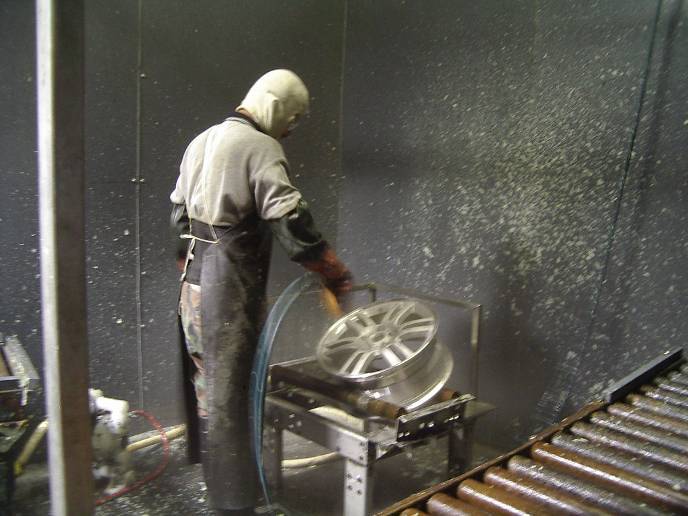To remove paint from alloy wheels, apply a chemical paint stripper and scrub with a soft brush. Ensure protective gear is worn and follow manufacturer’s instructions.
Stripping paint from alloy wheels refreshes the look of your vehicle while maintaining the integrity of the wheels. Many car enthusiasts face the challenge of unwanted paint or overspray on their alloy wheels. A common solution is using a chemical paint stripper designed for alloys, which breaks down the paint without harming the wheel’s material.
It’s crucial to choose a non-corrosive formula to avoid damage. Safety measures, such as gloves and goggles, are essential to protect against harmful chemicals. Afterwards, a gentle scrubbing with a soft-bristled brush can help lift the paint away. This method proves effective in restoring wheels to their original appearance, making your car look well-maintained and increasing its aesthetic value.
Introduction To Alloy Wheel Paint Removal
Alloy wheels elevate the appearance of any vehicle, offering both aesthetic appeal and performance benefits. Over time, their paint can become chipped, faded, or damaged due to various factors such as road debris, harsh weather, and curb scrapes. Refresh your wheels by removing the old paint, which preps them for a new coat, enhancing their look and preventing corrosion and wear.
Successfully stripping paint from alloy wheels demands care and attention to avoid damaging the metal. Users should be aware of the right materials and methods that are both effective and safe. Opt for non-toxic, alloy-friendly chemical strippers, and always use protective gear such as gloves and goggles. Testing any chosen method on a small, inconspicuous area first can help ensure that it doesn’t compromise the integrity of the alloy.

Credit: www.mileschemicalsolutions.com
Preparation For Paint Removal
Prior to embarking on the removal of paint from your alloy wheels, gathering the right tools and materials is crucial. You’ll need chemical paint stripper, protective gloves, safety glasses, and respirators to shield against harmful fumes. Additionally, have on hand wire brushes, steel wool, and plastic scrapers for scrubbing off loosened paint.
Do not overlook the importance of safety precautions. Equip yourself with the proper safety gear to prevent any chemical burns or inhalation hazards. This includes donning long sleeves and pants to protect your skin. Pre-cleaning the wheels is vital; ensure that dirt and debris is thoroughly removed. Mild soap and water should suffice for this initial clean-up. Once clean, your wheels are now ready for the paint removal process.
Chemical Paint Removal Techniques
Choosing the Right Chemical Paint Stripper requires assessing the type of paint and alloy material to ensure compatibility. Preferably, select a stripper labeled specifically for alloys to avoid damage. Non-toxic strippers with lower Volatile Organic Compound (VOC) levels are recommended for health and environmental reasons.
Application of the Paint Stripper should be precise and methodical. Begin by applying a generous layer of the stripper onto the paint-covered areas of the wheels. It’s imperative to follow manufacturer’s instructions regarding time for the stripper to act. Do not rush this step, as allowing the chemical to work properly is essential for optimal results.
- Work in a well-ventilated space to minimize inhalation of fumes.
- Use protective gear, like gloves and safety glasses.
- Always test on a small area first to gauge the stripper’s effectiveness.
- Dispose of waste materials in accordance with local environmental regulations.

Credit: www.reddit.com
Mechanical Paint Removal Methods
Mechanical paint removal methods offer a variety of techniques to clear away unwanted paint from alloy wheels. Sandblasting equipment is a powerful tool that can strip paint by propelling abrasive material against the wheel’s surface at high velocity. This method is prized for its efficiency and ability to reach nooks and crannies that other methods might miss.
In contrast to sandblasting, bead blasting utilizes tiny beads made typically of glass or plastic. The primary benefit of bead blasting techniques lies in their ability to clean the surface without causing damage or warping to the metal beneath, making it ideal for sensitive alloy compositions.
Hand sanding remains a popular choice for those requiring precise control over the paint removal process. It allows for meticulous attention to detail and is particularly useful for delicate areas where overspray could be a concern. Although more labor-intensive, it ensures that only the unwanted paint is removed, thereby preserving the integrity of the wheel’s design.
Post-removal Processes
Cleaning and neutralizing chemical residues is a crucial step following the removal of paint from alloy wheels. Begin by thoroughly rinsing the wheels with clean water to eliminate any remaining paint stripper or debris. Afterward, apply a neutralizing solution to counteract the corrosive effects of the chemicals used. Use a soft cloth or sponge to ensure that the solution reaches all nooks and crannies, preventing potential corrosion.
Once the wheels are clean, proceed with inspection and touch-ups. Scrutinize the alloy surfaces for any signs of damage or areas where paint residues might persist. In these instances, employ a small brush or sanding tool for precise removal. Ensuring that the surface is impeccably clean and smooth will go a long way in preparing it for the next steps.
To prepare the alloy wheels for repainting, start by lightly sanding the entire area to create a smooth, adhesive surface. After sanding, clean the wheels again to remove any dust or particles. Apply a high-quality primer coat designed for alloy materials, providing an optimal foundation for the new paint. Once the primer is dry, your wheels are ready for the fresh coat of paint that will restore their original luster.

Credit: m.youtube.com
Best Practices And Tips
Removing paint from alloy wheels demands attention to detail to avoid damaging the wheel surface. One common mistake is using abrasive materials which can scratch or gouge the wheels. Always select non-abrasive tools and gentle chemical paint removers designed for alloys. Additionally, skipping the necessary preparation steps, such as washing the wheels to remove dirt and debris, can lead to suboptimal results.
Embracing patience and precision is vital. Rushing the paint removal process or using shortcut methods could cause irreversible wheel damage. Proper technique involves applying the remover evenly and allowing it to sit for the recommended time before gently wiping or brushing the paint away.
Once the wheels are paint-free, long-term maintenance includes regular cleaning, applying a protective sealant, and quick response to any future paint spills before they harden. This will ensure the alloy wheels remain in pristine condition and reduce the need for future paint removal.
Frequently Asked Questions Of How To Remove Paint From Alloy Wheels
How Do You Get Paint Off Alloy Wheels?
To remove paint from alloy wheels, apply a gentle, non-acetone-based paint remover. Let it sit, then use a soft brush to scrub off the loosened paint. Rinse thoroughly with water afterward. Always wear protective gloves and test a small area first.
What Is The Best Paint Remover For Alloy Wheels?
The best paint remover for alloy wheels is a non-corrosive, environmentally friendly product like Citristrip or a gel-based formula such as CarPlan Nitro Mors. Always follow safety instructions and test a small area first.
How Do You Remove Paint From Aluminum Alloys?
To remove paint from aluminum alloys, use a chemical paint stripper suitable for metal, apply it carefully, and follow the product’s instructions. After the paint softens, gently scrape it off, and rinse the surface with water. Always wear protective gear to avoid skin and eye irritation.
Will Paint Thinner Remove Paint From Rims?
Yes, paint thinner can remove paint from rims, but use it cautiously to avoid damaging the underlying material. Always test a small area first.
Conclusion
Restoring your alloy wheels to their original luster is simpler with the right techniques and materials. By following the steps outlined, you can effectively remove paint without damaging the wheels. Remember, safety and patience are key to achieving that sleek, flawless finish.
Happy refinishing!







